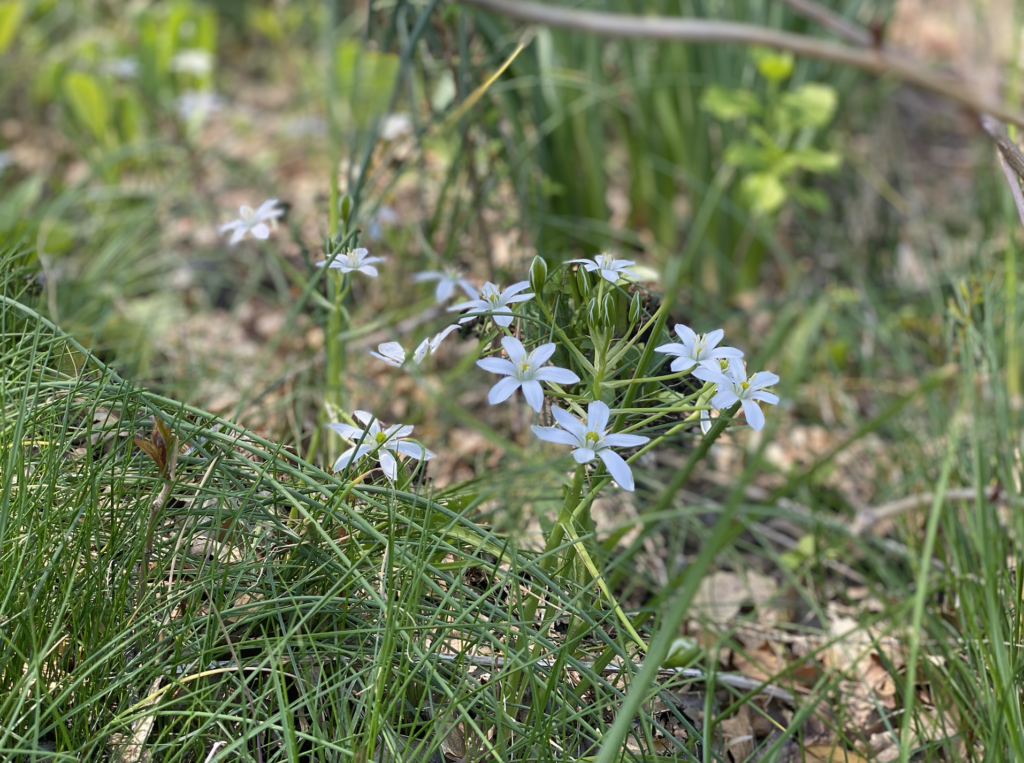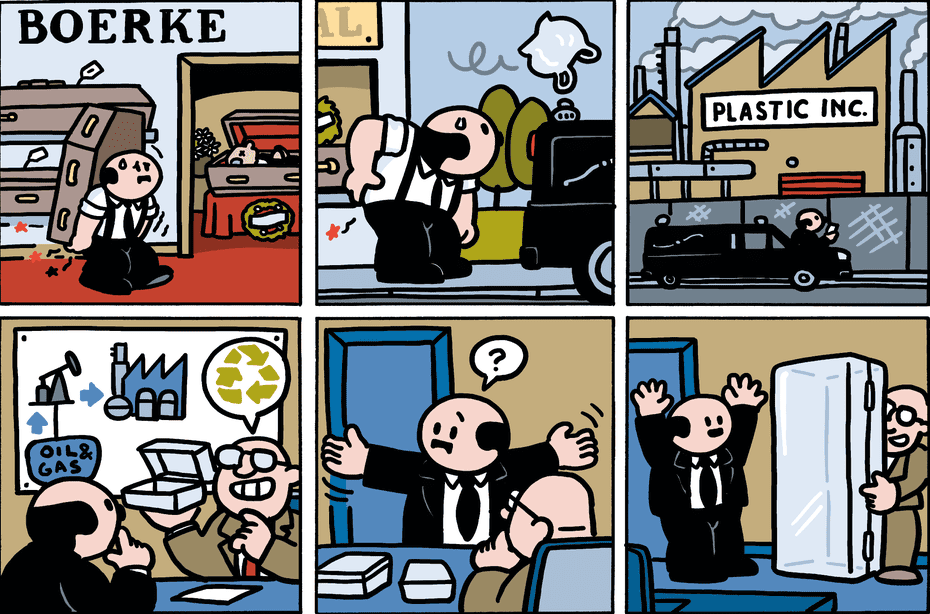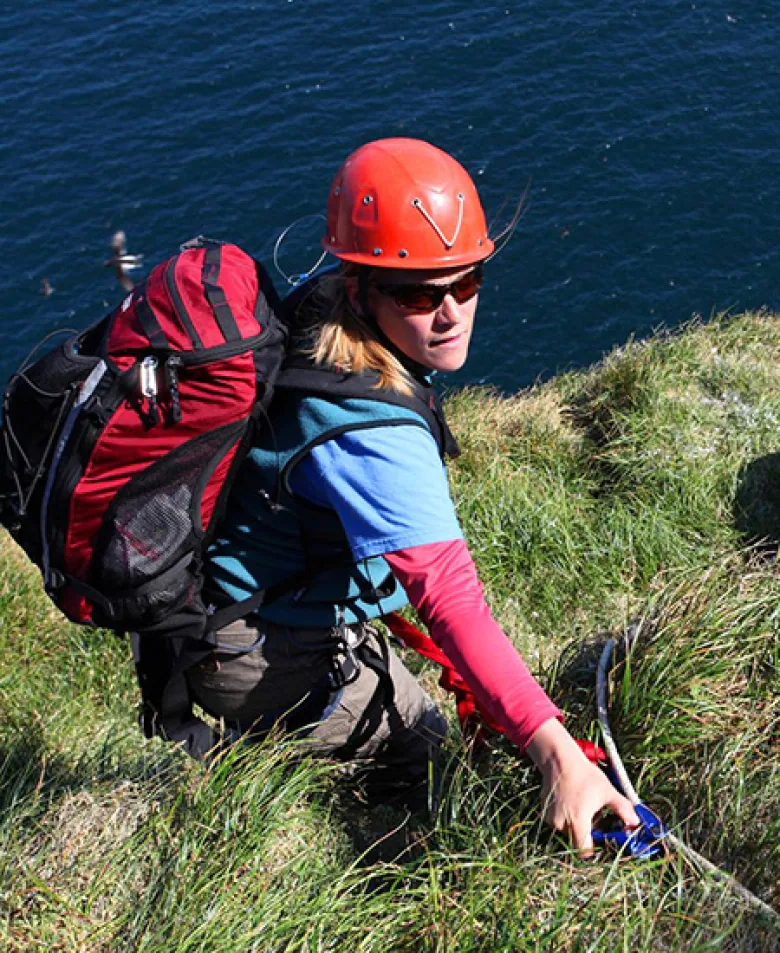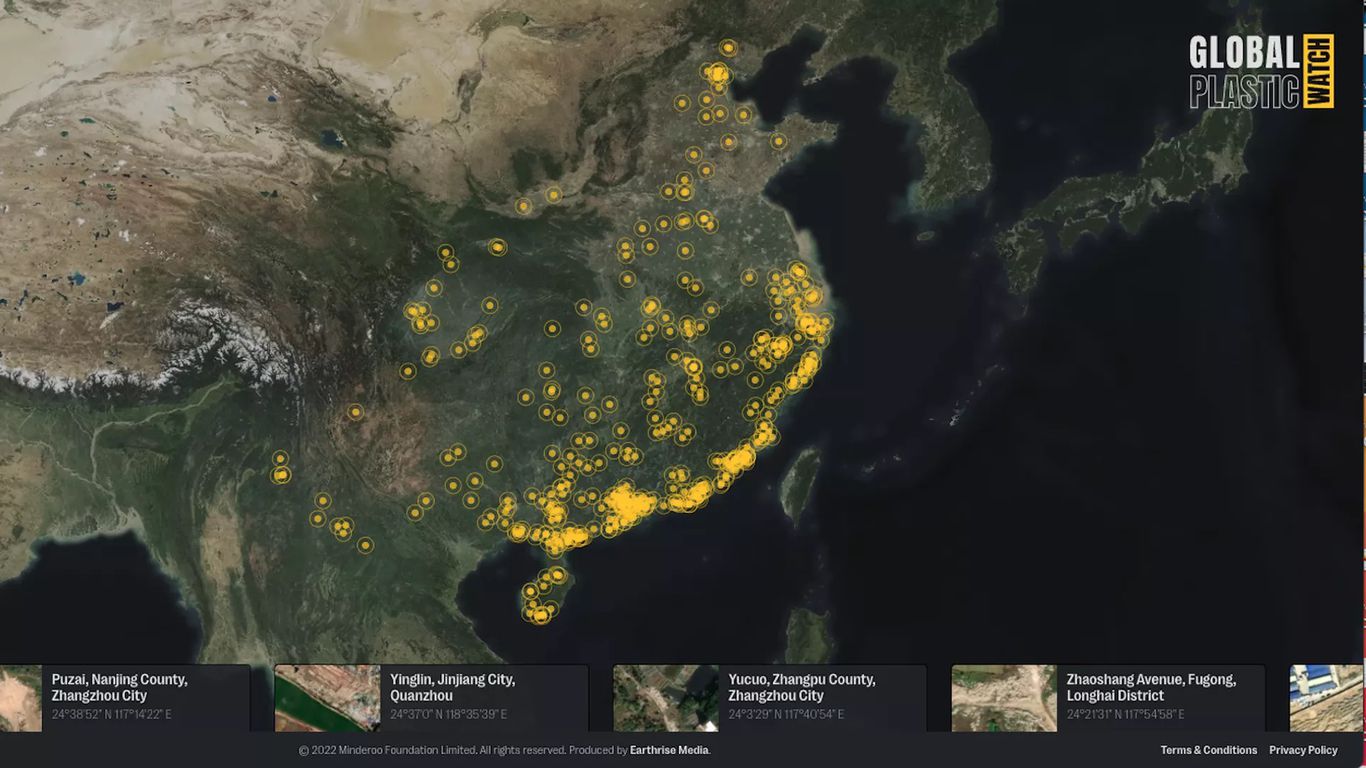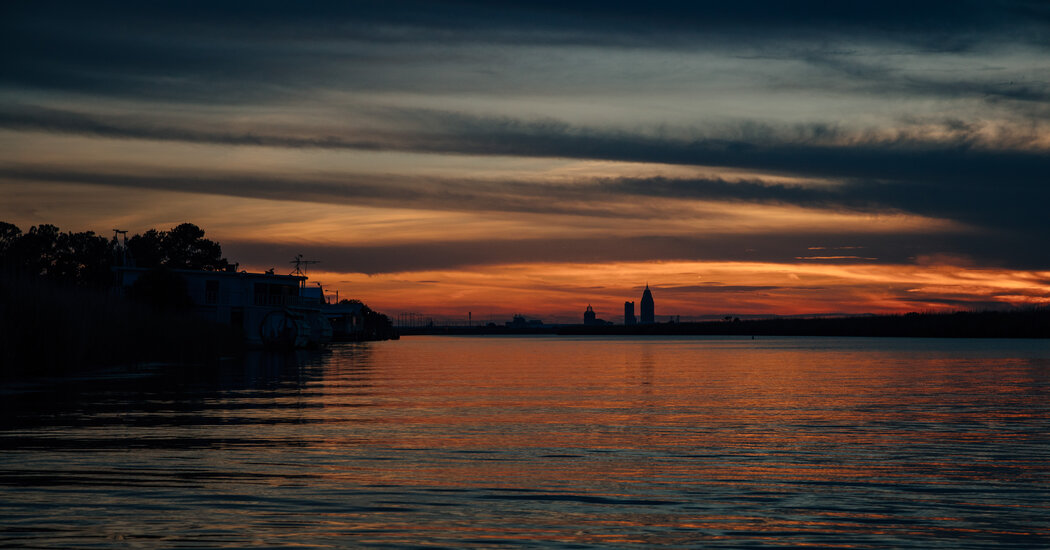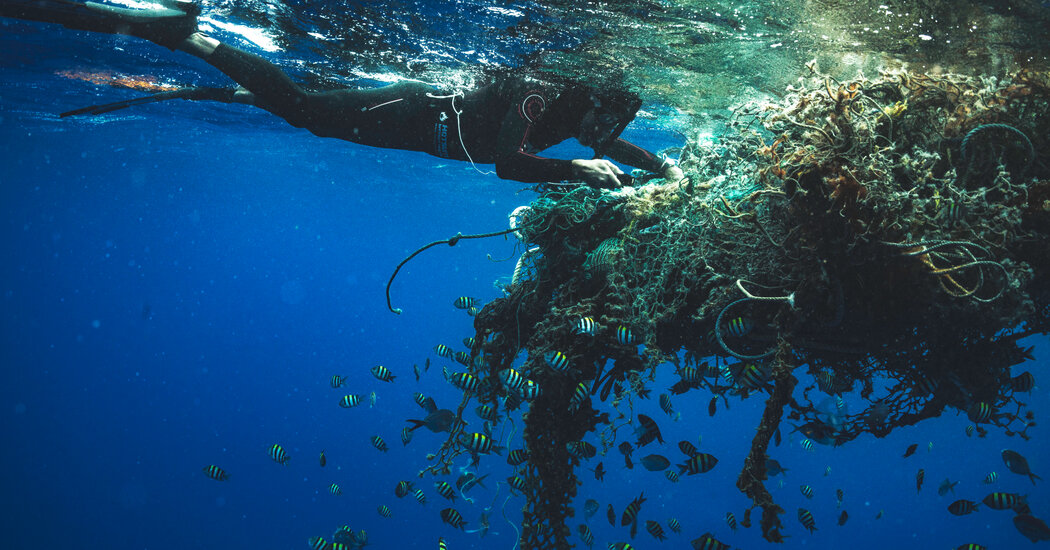SPRINGDALE, Pa.—If you stand in the sloping yard of the Rachel Carson Homestead and look southwest, down toward the Allegheny River, you can see the towers of the Cheswick Generating Station. Through the bare trees and thick green bramble that surround the house, the smokestacks emerge in the distance, twin pillars striped against a steel-silver sky. One is banded in orange and white, like a lighthouse; the other is dun-colored concrete. On this day in early spring, when birds are trilling and the smell of damp mulch fills the air, both towers are silent, because the plant was recently shut down.
When Rachel Carson was born here in 1907, this five-room white clapboard house about 18 miles east of Pittsburgh sat on 64 acres of farmland on the edge of town. The property included an apple and pear orchard, barn, and chicken coop. As a child, Carson explored the land around her home with enthusiasm. In one of her earliest essays, she writes about the trails “carpeted in fragrant pine needles” and the “thrill of exultation” she felt when she was outside on her own. Then, too, industry existed alongside the natural world; Carson would later recall the stench from the glue factory next to Springdale’s train station. When she was a teenager, West Penn Power built a coal power plant in Springdale. In her biography of Carson, Linda Lear writes about Carson’s adult distaste for what her hometown eventually became, “endlessly ugly” and “squeezed” between two “huge power stations.”
In the famous opening of “Silent Spring,” Carson describes a fictional, bucolic hamlet, a literary echo of the Springdale she knew as a girl. She evokes a place that is still familiar to anyone who has spent time in Pennsylvanian woods. “There was once a town in the heart of America where all life seemed to live in harmony with its surroundings,” she writes. “The town lay in the midst of a checkerboard of prosperous farms, with fields of grain and hillsides of orchards where, in spring, white clouds of bloom drifted above the green fields.” She writes about the vivid maples and striking birches, the nodding ferns and wildflowers, the deer and foxes and abundant fish who swim in clear, cold creeks, “the mists of the fall mornings.” Most of all, she writes about birds: the robins, wrens and doves whose voices come together in a “dawn chorus.”
Now the Carson homestead seems out of place on Marion Avenue, a relic from a bygone era. Tidy beds of tulips have replaced the wildflowers, and brick single-story houses and asphalt crowd in on all sides. The sounds of traffic and barking dogs and chatting neighbors cut through the birdsong, and the yard backs into Springdale High School’s parking lot. Springdale’s town website is proudly emblazoned with the slogan “The Power City,” while also offering information about Rachel Carson’s birthplace. Springdale is part of Pennsylvania’s newly redrawn 17th Congressional district, one of 26 races that the Cook Political Report considers a toss-up for 2022. The issues of the environment, energy and jobs are front and center in the May 17 primary election election.
The Generating Station was permanently closed earlier this month after 50 years of operation. It was the last coal-fired power plant in the county and one of the last in Pennsylvania, and 50 people lost their jobs in the closure. The planned demolition of the plant stirred concern in some residents, who worried about the economic impact on businesses in their small community. GenOn Holdings, the plant’s owner, was also a source of financial support for Springdale in the form of donations to churches, parks, emergency management services, and projects like GenOn field, a baseball diamond built in 2012 for which the company donated more than $17,000.
Some residents were relieved to escape the plant’s pollutants (it was one of the largest sources of air pollution in the area) and eager to see the site converted into something else. In 2012, two Springdale residents filed a class-action lawsuit against GenOn, alleging that emissions from the station were damaging their property and making them “prisoners in their homes,” subject to “fly ash, barium compounds, copper compounds, dioxin and dioxin-like compounds, hydrochloric acid,” and other harmful chemicals. One of the plaintiffs complained about “black particulates and sulfur odors” that she believed were causing her children to get headaches. The residents ultimately won the right to sue the plant, and that decision has been called “a guide for future plaintiffs” pursuing cases about local pollution.
Flowers grow in the yard of the Rachel Carson Homestead in Springdale, Pennsylvania, May 9, 2022. Credit: Katie Surma
Sometimes these opposing viewpoints are embodied in one person at the same time. “Me, personally, I think it’s good they’re shutting down,” a local worker told Trib Live in 2021, when the closure was announced. “I think that it’s going to be kind of good for the environment.” But he was also worried about the disappearance of the steady stream of customers patronizing Springdale’s bars, restaurants, and the beer distributor where he worked, Beer & Beyond.
This is an old story in Southwest Pennsylvania, a well-worn narrative about the hard choices to be made between opportunity and public health, prosperity and preservation, stability and safety. For nearly as long as there has been European settlement, people here have benefited from—and been subject to the dangers unleashed by—the fuels beneath their feet. In the past, it’s been a story about the cost of survival and what must be endured in order to get by, whether that meant “killer smog,” lung disease, or industrial accidents like the Harwick mine disaster of 1904, which killed 181 people in Cheswick, the town neighboring Springdale. Today, this familiar fight has taken on heightened urgency. Depending on who is telling the story, that urgency has been brought on by the climate crisis and the harmful effects of the fracking boom. Or it’s tied to gas prices, unemployment, and foreign oil.
Politicians, like the candidates running in the 17th Congressional district, try to have it both ways when it comes to jobs and the environment. The Democrats speak about the urgency of responding to climate change and tend to emphasize the jobs that could be created in that response, and Republicans promote oil and gas investment and fracking as engines of economic growth. Candidates from both parties say they want to protect residents from pollution. But few people think that it might be possible to craft an entirely new story about this part of the country, a story that doesn’t revolve around fossil fuels.
The Cheswick Generating Station and smokestacks located mere blocks from the Rachel Carson Homestead in Springdale, Pennsylvania on May 9, 2022. Credit: Katie Surma
Bob Schmetzer, a member of a local grassroots environmental group, the Beaver County Marcellus Awareness Community, who has lived in the area all his life, explained the trade-offs as people perceive them by harkening back to the old days when so many depended on the steel mills for their livelihoods and grandmothers swept soot off their porches every night. The thinking went like this, he said: “As long as there is dirt to sweep, we’ll have food to eat.”
“There’s a feeling of ‘we trade our health for jobs’ here,’” said Terrie Baumgardner, who works for the Clean Air Council in the region. “That’s what we do.”
A Plastics Plant 30 miles from Springdale
There is a story from Rachel Carson’s childhood about what first triggered her lifelong love for the ocean, the subject of so much of her writing. She grew up far from the sea, but townspeople in Springdale later remembered that she once found a “large fossilized shell in the rocky outcroppings of her family’s hillside property,” Lear writes, of a little girl gazing down on something left behind by an ancient ocean, captured in her palm. “She wondered where it had come from…and what had happened to the sea that had nurtured it so long ago.” Three hundred and ninety million years ago, western Pennsylvania was covered by an inland sea. Detritus from that sea eventually formed the Marcellus Shale, the vast deposit that is the source of the natural gas coveted by petroleum companies in the 21st century.
About 30 miles from Springdale, along the Ohio River in Beaver County in the town of Monaca, an ethane cracker plant being built by Royal Dutch Shell is the latest and largest development to take advantage of the natural gas found in the Marcellus Shale. “Cracker” is shorthand for the process used to break down the gas molecules into smaller molecules. It is slated to open sometime in 2022. During the construction, which began in 2017, parking lots for the struggling Beaver Valley Mall filled with buses for workers and cars with out of state license plates.
The plant will use ethane to make 1.6 million tons a year of tiny plastic pellets called “nurdles,” which are “feedstock” that can be made into a range of plastic products. It is permitted to emit 2.2 million tons of carbon dioxide equivalent into the atmosphere.
Each year, around 230,000 tons of nurdles find their way into Carson’s beloved oceans, where they are consumed by fish and wildlife; they are the ocean’s second-largest source of micropollutants.
The plant “marks a major expansion of the natural gas industry into downstream supply chain production,” according to “When Fracking Comes to Town,” an academic anthology about natural gas extraction in America. It is the “first facility of its kind” in the Marcellus Shale, the “first investment by Royal Dutch Shell outside of the Gulf Coast area in 20 years,” and its construction was made possible by $1.7 billion in tax credits from the state.
The cracker plant was built on the same site as a zinc smelting facility that was shut down in 2014, taking with it 600 jobs and thousands of dollars in local tax revenue. Though Shell employed 6,000 workers during the construction phase, in normal operations, the company expects to employ 600 people.
Rachel Carson’s Legacy
On an unusually hot spring day, I met with a group of people concerned about the Shell plant’s environmental and health impacts at the Allegheny Health Network’s Cancer Institute in Beaver County, a gleaming new building behind the mall and across from Rural King, a farm supply store. Warmth radiates through the soles of my shoes from the baking pavement; there is hardly any shade here, only a few spindly, immature trees. Where Rachel Carson was focused on the effects of pesticides used in agriculture, today many environmentalists in Pennsylvania are most worried about the powerful oil and gas industry and its encroachment on residential areas and public parks.
Karen Gdula arrived first, petite and friendly, though focused and matter-of-fact when she’s describing her experiences with the natural gas industry. In September 2018, Energy Transfer’s Revolution pipeline exploded behind her house on Ivy Lane, only a few miles away from where we were standing. Gdula keeps a carefully organized binder of the events of that day and its aftermath, with photographs showing the cindered remains of one of her neighbors’ houses, a charred outline where a home used to be. “As a child, I had a recurring nightmare that the woods behind my house were on fire,” Gdula said. “And that morning, my childhood nightmare became a reality.” Now, she’s worried about the Shell plant.
In March, Shell reported a 2,500-gallon spill of sulfuric acid to the federal government’s National Response Center, according to a local report and the response center’s database. Although the spill was contained at the site, Gdula is concerned about the potential for spills like it to contaminate her water supply in the future. “It’s a big concern for me,” she said.
Shell did not return telephone or electronic message requests for comment on the spill or its plans to protect the public and the environment from water or air pollution.
I asked Gdula if she had ever considered moving. Her parents built her house in 1957, and it’s where she grew up. Ivy Lane is a charming, welcoming neighborhood. Gdula’s gardens are bursting with daffodils, her back porch laden with bird feeders, swinging in the breeze.
“Believe it or not,” she said, in recent months “there have been bidding wars for the houses in this neighborhood.” But none of this is why she hasn’t left. “My neighbor who now lives closest to the pipelines went out looking for a new house, and she found one she loved,” Gdula said. “She walked outside and she looked around and she realized that Revolution was there too.”
At least, Gdula concluded, the pipelines in her neighborhood were 300 or 350 feet away from her home, rather than 30. “There’s no guarantees when you move,” she said. Even if she bought a house with no pipelines in sight, there was nothing to stop another company from seizing and building on nearby land. The Shell plant alone requires 97 miles of pipeline and 1,000 fracking wells to feed it.
Next to arrive was Baumgardner, soft spoken and wearing metallic pink glasses, which glinted in the sun. Baumgardner works for the Clean Air Council as the Beaver County Outreach Coordinator. Baumgardner has worked with Clean Air Council since 2016, but she first became involved with environmental issues through Beaver County Marcellus Awareness Community, the same organization that Schmetzer is part of. The community has its own citizen watchdog group devoted to monitoring the cracker plant, “Eyes on Shell.”
Clifford Lau joined us later, sporting a thick gray mustache and the air of someone who is used to delivering educational lectures about complicated topics. Lau teaches chemistry and environmental science and is an adjunct professor at Duquesne University. He is full of detailed knowledge about the Shell plant and strategies for monitoring the plant’s effects on the air and water. He told me that he hasn’t been to the Rachel Carson house, but he does talk to his students about Carson. “A lot of them don’t know about ‘Silent Spring,’” he said.
The Shell plant can be seen from an overlook adjacent to the Cancer Institute parking lot, and we peered over the edge. Blackened, broken trees on the nearest hillside looked like snapped matchsticks. Below this ridge, the plant sprawled like a space-age city, all shiny turrets and blinking lights and fleets of silver railcars, extending to the shores of the blue-green Ohio. “I can see the glow in the sky from my house at night,” Gdula said. “The week that they lit their pilots, I heard the rumbling.”
Lau recalled attending a Pennsylvania Department of Environmental Protection meeting about Shell’s Falcon pipeline in Washington County, which borders Allegheny and Beaver counties. The meeting was held at night at a junior high school on top of a hill. “It just struck me when I was out in the parking lot and I could see all the lights of the wells and the flares, and thinking, 10 years ago, that would have been perfectly dark, a nice starry night,” he said. “We’re actually having a chemical plant built around us.”
A historical marker on the Rachel Carson Homestead in Springdale, Pennsylvania, on May 9, 2022. Credit: Katie Surma
Baumgardner pointed out the town of Beaver, about two miles north of the plant on the other side of the river. “It’s a really nice town. I lived there for 14 years, and it got nicer every year until this thing came,” she said. She indicated a residential area of Beaver called River Road. “I’m surprised those people have not put up more of an outcry.”
“I know someone who lives down there,” Gdula said. “I asked her if there was concern. She said, no, she thinks they live far enough away.”
“What we have a fear of here,” Lau said, “is the fact that unlike in Louisiana and Texas and Oklahoma, where it’s very flat, here, they’re right down in the valley.” Like Springdale, Beaver was built into the sloping valley formed by the movement of the river long ago. The land around the Ohio River is like a giant, populated funnel.
“None of their stacks are really above the ridgelines, so if things are going to come down, the valley’s going to act like a big pipe,” Lau went on. “Depending on which way the wind is going, either it’s going to go that way toward Beaver. Or if the wind’s coming from the opposite direction,” he gestured to the west, and the wind picked up. “It’s gonna go that way toward Ohio and Steubenville.”
Was worry about the Shell plant’s pollution a frequent topic of conversation among people who live near Monaca, especially as the plant nears operation? “Not at all,” Gdula said. “I have to bring it up and then usually their eyes roll back in their head.”
“The response I get is that they haven’t had time to look into it,” Lau said. “And I’m trying to say, well, what’s a better time to look into it?”
“Beaver County has had a lot of manufacturing with chemicals and smells,” Gdula said. “It’s almost like it’s part of the DNA of Beaver County: ‘My father worked in the mill; my grandfather worked in the mill, and yeah, their life got cut short,’ but you know,” she paused. “It’s accepted.”
What Would Rachel Carson Think?
The next morning I woke up at 6:30 a.m. to join a group of hikers who were training for the Rachel Carson Challenge, an all-day endurance event that is held annually in June on the 45-mile trail that shares Carson’s name. We would begin in Emmerling Park and end almost nine miles away in Springdale, passing by Carson’s homestead.
We followed yellow blazes through the flat gravel paths of Emmerling Park up to the first hill, finding our footing among roots and stones that lined the switchbacks. The route alternated between narrow, wooded trails, where the only noises were the birds overhead and the sound of creek water rushing over rocks, and quiet neighborhoods, where we walked on the shoulder of the road, through tunnels and past construction sites. In between there were steep, muddy inclines, cut like ski runs through the bare trees. My boots slipped in the dirt, and I was jealous of the hikers who had thought to bring hiking poles. When we started, the morning was chilly enough that goosebumps stood on my arms, and I noticed the sparkle of dew on the grass. We climbed hill after hill with the sun hot on our necks, and I was soon warm enough to stow away my sweatshirt. At mile seven, I bent down to submerge both of my hands in the cold water of a stream that crossed the trail.
As I hiked, I was struck by the beauty of the landscape: the undulating hills, the gaps in the trees where I could see the valley unfold all around us, the violets and dandelions growing at the edges of the path, wind chimes pealing in the distance. But I also noticed signs of something surprising: industry. About an hour in, I saw the first marker for a natural gas pipeline, a white post that was stuck like a milestone in an open field. “Warning,” it read, with a number listed for emergencies. Soon after, I spotted another one, poking out of the ground near a traffic cone. Others, bright yellow, sprouted along the route as we walked. We passed locked metal fences with the same red Eastern Gas Transmission and Storage logo as the pipeline markers and a vast, glittering coal ash pile, where part of the path turned black and silky beneath our feet. Rainwater pooled in thick tire tracks in the mud. (A few hundred feet from one section of trail, there is a fracking well built by Range Resources, which has paid to help sponsor the Challenge in the past.)
Keep Environmental Journalism AliveICN provides award-winning climate coverage free of charge and advertising. We rely on donations from readers like you to keep going.Donate Now

